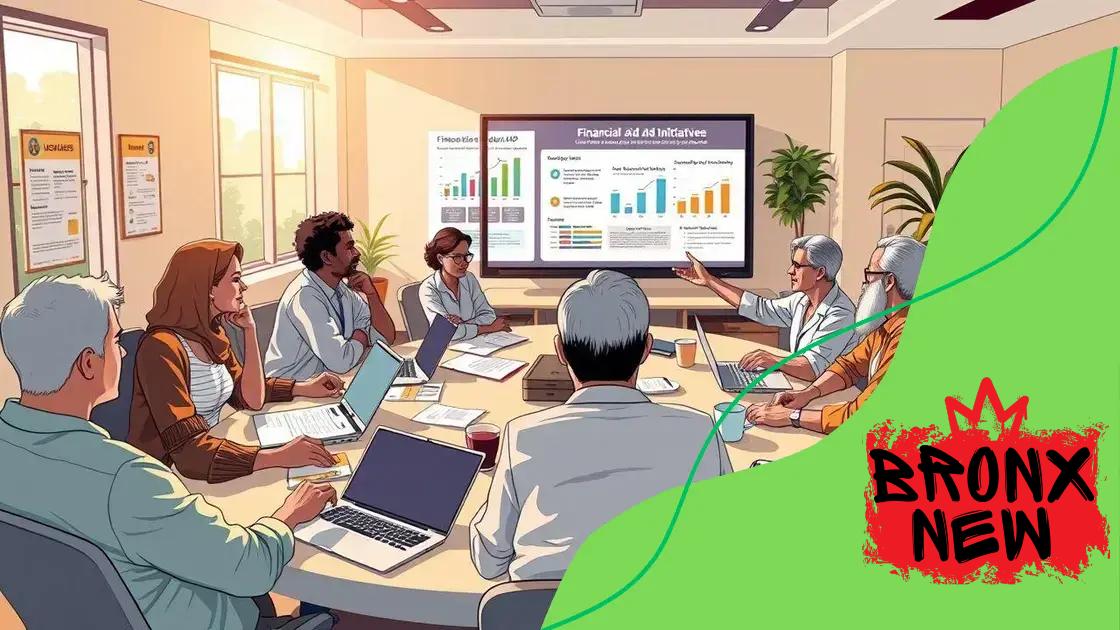Emergency financial relief programs in response to crises

Emergency financial relief programs provide essential assistance during crises, offering support for housing, food, and basic needs to individuals and families affected by disasters or economic challenges.
Emergency financial relief programs in response to crises play a vital role in helping individuals and communities navigate tough situations. Ever wondered how these programs actually work and who qualifies for them? Let’s dive in.
Understanding emergency financial relief programs
Understanding emergency financial relief programs is essential when crises strike, helping individuals and families regain stability. These programs can vary significantly based on the situation and need, offering much-needed financial support in tough times.
Several types of programs exist to address specific challenges. Knowing what’s available can empower you to navigate these circumstances more effectively. For instance, government initiatives often focus on immediate relief during natural disasters, while community organizations may offer long-term assistance.
Types of Emergency Financial Relief Programs
Emergency financial support comes from different sources, with unique criteria and structures. Here are some common types:
- Federal disaster assistance
- State welfare programs
- Nonprofit organizations providing grants
- Private sector loans and funding
Each type of program is designed to meet various needs. In federal disaster assistance, for example, the government provides quick funds to affected areas, allowing residents to recover faster. State programs may focus on more localized support, addressing specific communities’ challenges.
How Do They Work?
Understanding how these programs operate can simplify the process of getting help. Generally, most programs require proof of need, such as income loss or property damage. It’s vital to gather relevant documentation ahead of time, as this can speed up your application.
One common aspect of many relief programs is the application process. Many requests can be submitted online, which is convenient for people affected by crises. This accessibility plays a crucial role in ensuring that individuals get the help they require promptly.
In addition, staying informed about your eligibility is key. Many programs have specific criteria, so understanding these can make or break your chances of receiving assistance. Regularly checking for updates on program offerings is important, especially in times of widespread emergencies.
How these programs respond to different crises
How these programs respond to different crises is a crucial aspect of understanding their role in society. Emergency financial relief programs are not one-size-fits-all; they adapt to various situations like natural disasters, economic downturns, and public health emergencies.
For instance, during a natural disaster like a hurricane or earthquake, specific programs are activated to provide immediate assistance. Federal agencies often step in to offer funds for housing, food, and medical care, helping affected families rebuild their lives.
Responses to Economic Crises
In times of economic turmoil, such as a recession, emergency programs shift focus. They may provide unemployment benefits and financial aid to businesses struggling to stay afloat. This support is vital for preventing widespread economic collapse.
- Job training programs to help displaced workers
- Small business loans with low-interest rates
- Food assistance for families facing hardship
- Rent and utility support to prevent homelessness
The focus on public health emergencies, such as the COVID-19 pandemic, has also led to new financial relief strategies. Many governments introduced direct cash payments to individuals and families, aimed at cushioning the financial blow caused by lockdowns and health risks.
Customizing Support for Diverse Needs
What’s significant is that these programs are tailored based on community needs. Local organizations often collaborate with government entities to ensure that resources are allocated effectively. For example, in a specific city, support may prioritize vulnerable populations, including seniors, low-income families, and essential workers.
This responsiveness enhances the effectiveness of emergency financial relief programs, making it easier for communities to recover. By understanding the unique characteristics of each crisis, programs can allocate resources where they are most needed, demonstrating a flexible approach to assistance.
Eligibility criteria for relief programs

Eligibility criteria for relief programs can be complex, but understanding them is vital for accessing necessary assistance. Each program has specific requirements that determine who can receive help during a crisis.
Often, eligibility is based on factors such as income, family size, and the nature of the crisis. For example, during a natural disaster, programs might prioritize those whose homes were damaged or destroyed. In economic downturns, individuals with job loss may be the main focus.
Common Eligibility Requirements
Here are some typical criteria to keep in mind:
- Proof of income or unemployment status
- Documentation of damages or loss
- Residency requirements
- Immediate need for assistance
In many cases, applicants must provide documentation to verify their circumstances. This could include pay stubs, tax returns, or government identification. Keeping these documents organized can make the application process much smoother.
Special Considerations
Other factors may also affect eligibility. For example, some programs are designed specifically for vulnerable populations, such as seniors or individuals with disabilities. Recognizing these exceptions can help individuals ensure they are applying for the appropriate assistance.
It’s also important to stay updated on any changes to eligibility criteria. As circumstances evolve, relief programs may adjust their requirements to better serve those in need. Regularly checking for updates on local and federal assistance programs can provide timely information to applicants.
Application processes for financial assistance
Application processes for financial assistance can vary widely, but understanding them is essential for obtaining help in times of need. Each program typically has its own set of steps that applicants must follow to receive aid.
Generally, the first step is to determine your eligibility. This often involves checking the specific criteria for the program, such as income limits or residency requirements. Once you confirm that you qualify, you can proceed with the application.
Steps to Apply for Financial Assistance
Here are some common steps you might encounter:
- Gather necessary documents, including ID, proof of income, and any relevant forms.
- Fill out the application form accurately, ensuring all information is correct.
- Submit the application online or in person, depending on the program.
- Follow up for updates and provide any additional information if requested.
It’s important to pay attention to deadlines. Most financial assistance programs have specific timeframes in which applications must be submitted. Delaying your application can result in missed opportunities for support.
Helpful Tips for a Successful Application
To improve your chances of a successful application, consider these tips. Double-check all your documents to ensure they are complete and accurate. If you’re submitting online, make sure your internet connection is stable. It helps to have a contact person listed for follow-up questions from the program administrators.
Lastly, don’t hesitate to seek help if you need it. Many organizations offer assistance with the application process, so reach out to local community services if you’re unsure about how to proceed. This way, you can better navigate the financial aid landscape and access the resources available to you.
Real-life examples of successful relief efforts
Real-life examples of successful relief efforts offer inspiration and lessons learned from past crises. These instances show how effective programs can help communities rebuild and recover after disasters.
One notable example is the response to Hurricane Harvey in 2017. In Houston, Texas, numerous organizations, including the federal government, worked together to provide immediate aid. They set up shelters, distributed food, and offered financial assistance to those displaced. This multi-agency approach helped thousands regain stability.
Community-Driven Initiatives
Another successful relief effort occurred during the COVID-19 pandemic. Local groups mobilized to create food banks and provide essential supplies. Many communities organized volunteer networks to deliver groceries and medicine to vulnerable individuals. These grassroots efforts filled gaps where traditional systems fell short.
- Distribution of masks and sanitizers
- Setting up outdoor vaccination sites
- Community meals for families in need
- Financial counseling services
In addition, the wildfires in California presented a challenge that demonstrated the power of resilience. In response to these disasters, various organizations teamed up to offer mental health support alongside physical aid. These initiatives helped survivors process their trauma while rebuilding their lives, emphasizing the need for holistic support during crises.
Collaborative Partnerships
Successful relief efforts often occur through collaborations between governments, nonprofits, and community members. Such partnerships leverage resources and expertise. For example, after the 2010 earthquake in Haiti, international NGOs worked alongside local organizations to ensure aid reached hard-hit areas efficiently. This combined effort improved logistics and made access to assistance smoother.
These examples illustrate that when communities come together and leverage their resources, they can make a significant impact. By sharing stories of successful relief efforts, we can inspire future initiatives that meet the needs of those affected by crises.
FAQ – Frequently Asked Questions about Emergency Financial Relief Programs
What are emergency financial relief programs?
Emergency financial relief programs provide assistance to individuals and families during crises, such as natural disasters or economic downturns.
How can I apply for financial assistance?
To apply, gather required documents, check eligibility criteria, and fill out the application form provided by the relief program.
What factors determine eligibility for these programs?
Eligibility usually depends on income, family size, and the specific crisis affecting you, along with documentation proving your need.
Can I get support for non-financial issues?
Yes, many relief efforts also provide mental health support, job training, and community resources alongside financial assistance.





